Good and faithful servant
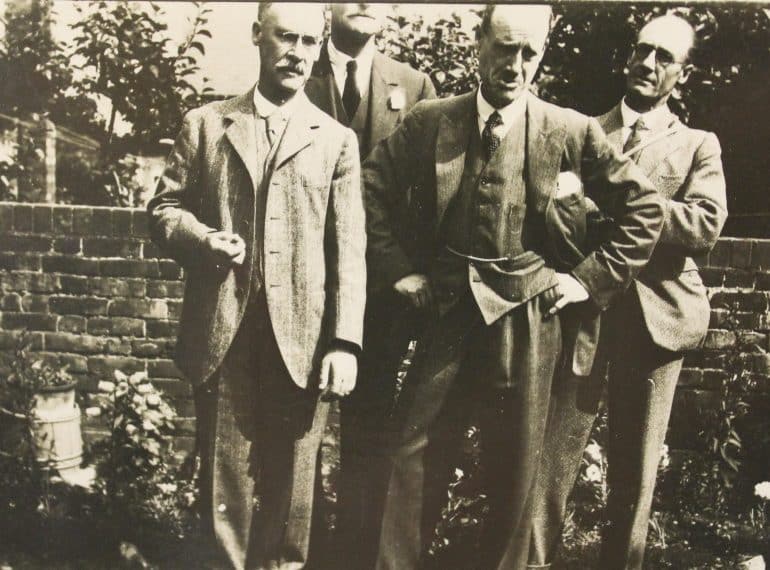
The Mayes building, which was demolished in the summer of 2019 to clear the site for QE’s new Music School, was named in honour of Harry Mayes.
Although neither a teacher nor a governor, Mr Mayes – or ‘Curly’, an early nickname that remained with him – occupies an important place in the 20th-century history of the School, serving for a remarkable 60 years as butler, porter, steward and caretaker. The main image here shows him, extreme left, with others. It was probably taken in the 1930s.
Born in 1874, he was first appointed with his wife by the Rev. John Bond Lee, whose headship had begun as far back as 1875. Starting work at the School on 12th October 1902, the couple were employed respectively as butler and cook to the Headmaster – at that time, the Headmaster still lived next door to the School and there were boarders in the schoolhouse. Mr Mayes was still working until a short period before his death on Remembrance Sunday, 11th November 1962.
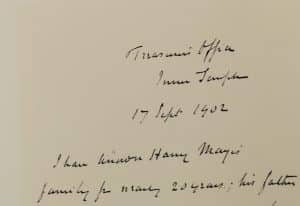 The School’s archive holds two references from the time of his appointment. One, written by Sir Henry Waldemar Lawrence (Bart), Sub Treasurer of the Inner Temple, who had employed Mr Mayes’ father, says: “I can speak in the highest terms of the family as thoroughly honest, sober and respectable people, devoted to their work and studying the interests of their employers.” The other, signed by John Gay, of Putney, stated: “For any work requiring a man of character and steadiness, I can strongly recommend him.”
The School’s archive holds two references from the time of his appointment. One, written by Sir Henry Waldemar Lawrence (Bart), Sub Treasurer of the Inner Temple, who had employed Mr Mayes’ father, says: “I can speak in the highest terms of the family as thoroughly honest, sober and respectable people, devoted to their work and studying the interests of their employers.” The other, signed by John Gay, of Putney, stated: “For any work requiring a man of character and steadiness, I can strongly recommend him.”
As an obituary in 1962 recalled, his duties were quickly expanded to encompass the general supervision of all the School premises, which in winter included the daily care of 12 coal fires in ten different rooms. Boys were on occasion “rather roughly reproved” for treating the buildings inappropriately.
This combination of hard work and a no-nonsense approach soon made their mark: “The 1914-18 war brought a severe shortage of competent schoolmasters and Mayes was frequently brought into a classroom to restore order,” the obituary recalled.
In 1932, he moved with the School to its current location, where the Lodge bungalow was built for him and his wife, still the School cook. Sadly, she died the following year; Mr Mayes remained a widower for his remaining three decades.
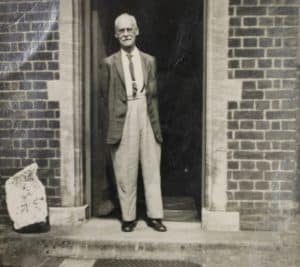 His duties continued to evolve in line with the changing needs of the School. He might, for example, be seen testing the water of the swimming pool for purity, once this facility had been provided through the donation of parental funds.
His duties continued to evolve in line with the changing needs of the School. He might, for example, be seen testing the water of the swimming pool for purity, once this facility had been provided through the donation of parental funds.
When QE was hit in a World War II bombing raid, on 11th January, 1941, the last Saturday of the Christmas holidays, the 67-year-old widower was walking up the driveway carrying a meal. He was knocked flat by the blast. In his biographical history, An Elizabethan Headmaster, E H Jenkins (1930-1961) recalled that “he was only annoyed at the indignity of being bowled over by a Boche [a German] and still more annoyed at the loss of a perfectly good supper.”
Mr Mayes was known for his total commitment: there was no question of working hours or overtime. When the bombing raids began, he considered himself on fire watch every night and flatly refused to take a day’s holiday.
Throughout his service, he simply regarded the School buildings as his responsibility at any time of day or night. Indeed, when staff thanked him for tackling some task that might have been regarded as beyond the remit of his duties, his invariable, cheerful reply was: “It is part of my job, sir.”
Even teachers did not always come up to his own exacting standards: “You can’t trust these young masters, sir,” he would tell the Headmaster when locking up the buildings after some late-evening function.
In 1953, after an operation to remove one of his eyes, members of the Common Room arranged for him to take a week’s holiday in Bournemouth. An hotel room was duly booked and the railway ticket bought for his Saturday afternoon journey to the coast. By the Monday he had had enough of idleness and returned to Barnet to do some work.
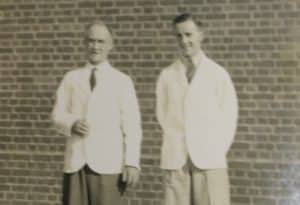 Notwithstanding his somewhat formidable personality, Mr Mayes (pictured here, left, with a colleague) was a retiring man who, in his later years, had to be coaxed to share stories from his early days. But his devotion to the School cannot be doubted: he was a proud honorary member of the Old Elizabethans Association, regularly wearing his OE tie on Founder’s Day. He would never forget a pupil, either, even if the OE returned to the School after a gap of some years.
Notwithstanding his somewhat formidable personality, Mr Mayes (pictured here, left, with a colleague) was a retiring man who, in his later years, had to be coaxed to share stories from his early days. But his devotion to the School cannot be doubted: he was a proud honorary member of the Old Elizabethans Association, regularly wearing his OE tie on Founder’s Day. He would never forget a pupil, either, even if the OE returned to the School after a gap of some years.
He was delighted when the governors and others marked his 50 years of service with a number of presentations and was equally pleased when it proved possible to bring him from the hospital to the School to congratulate him on his diamond anniversary just a month before his death. The tributes preserved from the latter occasion include a hand-written letter from the then-Headmaster, Timothy Edwards, who wrote: “It is quite impossible for us to express adequately our feelings of gratitude to you for all you have done, but I hope it is as clear to you as it should be that we are proud to have known you, grateful to you for all you have done, and, not least, humbled by your example of devoted and wholehearted service to the School.”
 There is also a letter from the staff (“a group of inexperienced youngsters”) noting the “coming and going of many masters” during Mr Mayes’ long service, some of whom stayed for a long time, with others just for a short period. “All, however, will always hold nothing but affection and respect for ‘Curly’,” the letter stated.
There is also a letter from the staff (“a group of inexperienced youngsters”) noting the “coming and going of many masters” during Mr Mayes’ long service, some of whom stayed for a long time, with others just for a short period. “All, however, will always hold nothing but affection and respect for ‘Curly’,” the letter stated.
Eye trouble continued to afflict him, as well as arthritis, with painfully swollen ankles occasioning his hospitalisation in the last few months of his life. After apparently making substantial progress to recovery, his death at Barnet General Hospital came as something of a shock, although it was a peaceful end, with his heart simply stopping.
In his book, the often-stern E H Jenkins paid warm tribute: “This fine servant, who had made his service to the School his pride and his life… was to be my great standby in any non-academic emergency for all but my last two years, when great age and increasing illness at last lowered his efficiency; and he had served the School as no one has ever more faithfully served any school, for no less than 60 years when he died…Molliter ossa cubent [May his bones rest gently].”
 The School was assiduous in honouring his memory: the hymn sung by the boys the morning after his death included the apt lines: “Forth in your name, O Lord, I go, My daily labour to pursue”. At his funeral in Barnet Parish Church, mourners included not only senior staff but also many other teaching and non-teaching staff, and a large number of pupils and old boys. The School Choir sang a hymn – Teach me, my God and King – and the 23rd psalm, while Assistant Master A R W Hayes played the organ. As the coffin was carried from the church, a team of boys rang a muffled peals on the church bells.
The School was assiduous in honouring his memory: the hymn sung by the boys the morning after his death included the apt lines: “Forth in your name, O Lord, I go, My daily labour to pursue”. At his funeral in Barnet Parish Church, mourners included not only senior staff but also many other teaching and non-teaching staff, and a large number of pupils and old boys. The School Choir sang a hymn – Teach me, my God and King – and the 23rd psalm, while Assistant Master A R W Hayes played the organ. As the coffin was carried from the church, a team of boys rang a muffled peals on the church bells.
The celebrant, Rev. C W Earle, Rector of Barnet, said: “He was like the man in the parables who was given five talents and used them to make five more, earning the commendation Thou Good and Faithful Servant.” Mr Mayes was buried at Christ Church burial ground, Barnet.
From his memorial fund, six teak seats were purchased and used for the first time by spectators at the cricket match between the School and old boys on Founder’s Day 1963. On that same day, a plaque was unveiled – opposite a plaque in memory of Mr Mayes’ first Headmaster, John Bond Lee – by Old Elizabethan Dr F Brittain, a Fellow of Jesus College, Cambridge. The plaque pays tribute to his service, exemplifying an ethic that still resonates strongly in QE today. It may be seen in the entrance hall.
